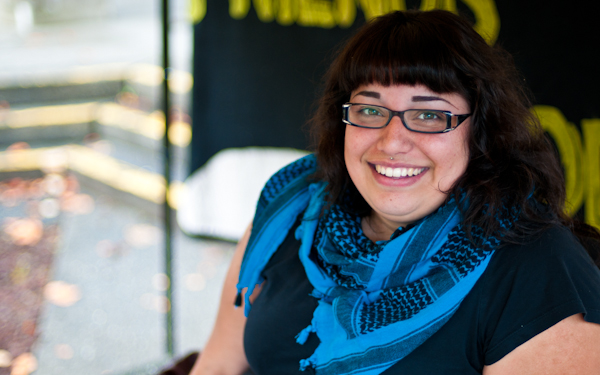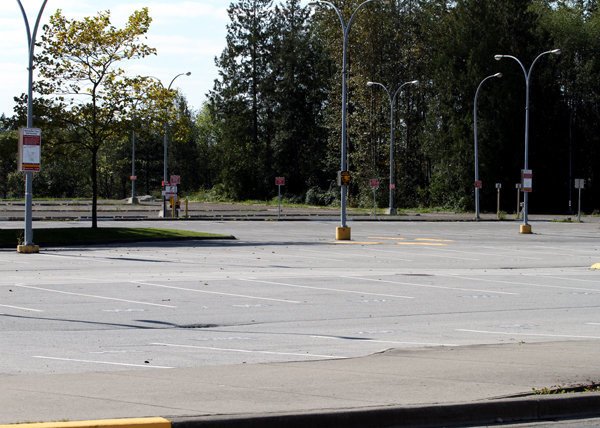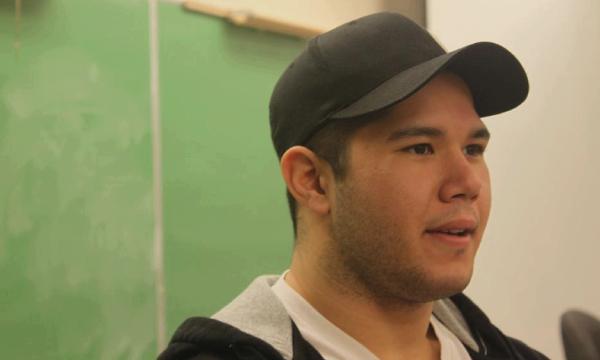Selective feticide still a problem in Canada
April 5, 2011 by Matt Law · Leave a Comment
Members of the South Asian community are putting faith in a new generation to change how women are viewed in their culture.
On March 5, over 70 people, many of them youths, gathered at Kwantlen Polytechnic University’s Surrey campus to take part in the Global Walk for the Missing Girls and to bring awareness to the problem of female feticide and infanticide.
Prominent members of the South Asian community made passionate speeches about the problem and then led people in a walk around the campus.
The walk took place in five countries and 16 cities around the globe in conjunction with International Women’s Day.
In the last century, 50 million girls have been lost from India’s population and in the last two decades 10 million have been killed by their parents either before or after birth.
With the introduction of cheap and portable ultrasound equipment the problem has become much worse.
Dr. Pargat Singh Bhurji, a pediatrician in Surrey, said the main reason for feticide and infanticide is dowry, which is a gift of money or estate that the bride brings to her husband when they are married. Other societal issues, like rape, have also contributed to increases in abortions.
“Eventually you need a uterus to be born. You cannot be born in the ground like potatoes or up on the tree like apples,” said Bhurji. “We are destroying our own future in a sense.”
While there are laws in India prohibiting doctors from identifying the sex of a fetus, no one has ever been charged.
Most people think of selective feticide and infanticide as being a problem in other parts of the world, like India and China, however, it is a much broader issue.

Dr. Pargat Singh Bhurji, a pediatrician in Surrey, talks to reporters after the Global Walk for the Missing Girls on March 5. The problem of female feticide is not just in India but happens in Canada as well. (Photo by Jeffrey Yip)
“It’s not a regional problem, it’s everywhere,” said Garima Kaur, the event’s organizer and an international student at Kwantlen.
The issue of selective feticide reaches as far as Vancouver and Surrey where it is supposed to be illegal for doctors to identify the sex of a fetus before a certain stage in pregnancy.
“There are clinics across the border, there are clinics in Surrey who actually advertise about this. ‘If you want to know if it is a girl child or a boy child and want to abort it then come here,’” said Kaur.
Pawan Dhillon, a maternity doctor in Cloverdale, has seen the issues of gender inequality here in Canada.
“In my experience it’s not as blatant as what we see in India,” said Dhillon. “I have been in deliveries where after I’ve announced ‘It’s a baby girl,’ it’s been met with silence. It’s not a common occurrence, but it is still there and it’s something that we need rectify.”
This was the first year the event was held in B.C. and Kaur hopes that it will continue to grow in the coming years. Reaching youth is one of her main priorities.
“If you encourage the youth, if you educate them that ‘let’s put a stop to it’, because they are the ones who are going to be parents now and in the future,” she said. “I think the solution is just in educating them — changing their mindsets rather than changing people who’ve already lived their 40, 50 years of life.”
Nursing students helping immigrant women
December 5, 2010 by Matt Law · Leave a Comment

(From left to right) Fourth-year nursing students Gillian Fantillo, Brianne Southcott, Krista Rohachuk-Smith and Kathryn Hull have worked to launch a new immigrant woman's clinic in Surrey as part of a school project. (Photo by Matt Law)
Nursing students in their fourth year at Kwantlen Polytechnic University are helping to lay the groundwork for a new women’s clinic in Surrey.
The goal of the clinic is to help educate immigrant women on sexual health and their rights in Canada.
“Basically, we are a link between the woman and primary health care,” said Krista Rohachuk-Smith, a nursing student at Kwantlen. “We do birth control counselling, [and providing information on] contraceptives, housing, abortion, domestic abuse is also something we do.”
The clinic started as a joint effort between the Progressive Intercultural Community Services (PICS) and Kwantlen instructor Dr. Balbir Gurm.
Students began working on the clinic in January 2010, paving the way for the current group of four students to continue their work and launch the program.
Funding has been tight for the start-up organization and they have received much of their material by donation. Office space and resources were provided by PICS and the Kwantlen Student Association has provided tampons and condoms free of charge.

The clinic offers information and education on womans sexual health, rights and abuse. (Photo by Matt Law)
“We’re hoping that once our grand opening happens and some of the local politicians come out and see, they might want to start offering funding for us,” said Rohachuk-Smith.
The clinic offers both anonymous consultation over the phone and email and in-person appointments and drop-in visits. And the clinic is free and confidential.
In many cultures, there are stigmas around women’s sexual health issues that make it hard for immigrants to seek help and advice. Abuse and lack of knowledge leave many women helpless.
“You hear a lot of stories about women who don’t know that rape exists within a marriage. You have a right to say no, you have a right to go on birth control, you have the right of the woman to decide how many children you want in Canada,” said Rohachuk-Smith.
In some cultures, women are not allowed to use birth control and often are refused access to it by family and physicians.
“The thing that we were most shocked about is hearing stories about women going to a doctor or going to a pharmacist to get treatment or birth control and having that pharmacist or doctor call their husband. That was the most shocking because according to their scope of practice it is supposed to be confidential and they don’t have the right to do that, but it happens,” said Gillian Fantillo, also a nursing student at Kwantlen.
The clinic has a number of resources to help women in these situations, including lists of pharmacies that are not safe to use, connections with the RCMP and legal groups.
The clinic held its grant opening at its office in Surrey last week. Office hours are Thursdays, 9 a.m.-3 p.m.
For more information on the clinic, email womens.clinic@live.ca, or call 604-596-7525, ext. 243.
Video: Kwantlen hosts Diwali Festival of Light
November 6, 2010 by Paul Fleischanderl · Leave a Comment
The Diwali Festival of Light came to all four Kwantlen campuses from Nov. 2-5. The event, hosted by the KSA, had food, music, henna tattoos, turban-tying and intercultural education. The video was produced at Surrey campus by Lucas Meneses-Skoda, Brittany Tiplady and Paul Fleischanderl.
Prayer room opens on Surrey campus
October 19, 2010 by Matthew DiMera · Leave a Comment
Surrey Kwantlen students looking to practise their faith now have an answer to their prayers, after the September opening of an on-campus dedicated prayer and meditation room.
The Centre for Student Life and Community quietly opened the prayer and meditation room in the learning centre in the Surrey campus library on Tuesday, Sept. 21. The initiative was created after the university received requests from students of different religious faiths seeking accommodation.
“Having the space available allows students of multiple backgrounds and faiths to be able to come in and make use of the space,” said Jody Gordon, the associate vice-president of students. The room has been made available seven days a week for use by students, staff and faculty as a space for quiet prayer and meditation, and can be booked in advance or used on a drop-in basis.
“But it’s not exclusive to those who may come looking for the space for religious purposes. It is also considered a secular space where someone may just need to the use the space to relax and let the stress go, that they’re often experiencing as students,” said Gordon.
The semiprivate and modestly-furnished room is used by an average of 10 to 12 people a day and the demand is already growing, according to Gordon. A student faith group on campus has also asked to use the space for its meetings.
She says that so far most of the requests for space have come from the Surrey and Richmond campuses, but she is expecting to offer similar a service on all the Kwantlen campuses as the space becomes available.
She said the department of Student Life will monitor the success of the pilot room with an eye to seeking improvements and meeting demand. “It’s a first and . . . modest attempt at trying to dedicate some space to quiet prayer and meditation,” said Gordon. “If this is something our community really wants to see us continue to have, then we want to continue to commit the resources to it.”
Amy Lange, a student representative for Kwantlen University Christian Ministries, has looked into using the room for her group’s weekly meetings, but discovered that the room can only accommodate six students and is too small for the group.
“While these changes are good, there is still a ways to go,” said Lange in an e-mail interview.
Students interested in using the space can call 604-599-2900 for more information.
Food fight at Kwantlen’s Surrey campus
October 7, 2010 by Jeff Groat · 1 Comment

Eva Botton is one of the lead organizers of Friends 4 Food, a vegan food provider at Kwantlen's Surrey Campus. Photo by Max Hirtz
Friends 4 Food is not friends with Sodexo.
The reactive Friends 4 Food was formed in opposition to what they see as “a corporate bully”, Sodexo, moving in as operators of Kwantlen’s cafeterias through what they say is an all-too-murky process.
Friends 4 Food is run by a small group of criminology students and serves vegan food to students in the Surrey campus courtyard four days a week, offering an alternative to what F4F sees as overly expensive and unhealthy food, provided by Sodexo at Kwantlen’s cafeterias.
In the first week of operations, F4F was shutdown by Fraser Health Authority and slapped with $615 in fines for various health code violations, but not before being warned by Kwantlen administration of the potential health violations and of not properly booking space in the courtyard at Surrey Campus.
The idea was to serve vegan food by donation to students who don’t wish to spend their money at Sodexo.
“We thought we’d call for a boycott, but we can’t really call for a boycott if we have no means for students to boycott it,” said Eva Botten, who is a lead organizer of F4F.
Started as a research project for a criminology class, F4F organizers looked into the history of the company now running the cafeteria at the school.
“So we’re trying to get [Sodexo] out,” Botten said.
On the Surrey campus, there are other food options, such as the student-run Grassroots Café, but campuses in Richmond, Langley and Cloverdale only have Sodexo-run cafeterias.
F4F has gained wide support from Kwantlen’s criminology faculty in its vocal protests against Sodexo on one side, but has been dealing with Kwantlen aministration and policy on the other.
“In an era where there is so much student indifference or apathy, to have a student who is smart and politically engaged and have some political moxie, is a student to be celebrated,” said Hollis Johnson, the criminology professor who assigned the project.
Johnson also harkened back to an incident over the summer when Emery Warner, another Kwantlen criminology student, was booted off campus for refusing to show identification while handing out leaflets protesting Sodexo’s (at the time) new place on campus.
“Why would anybody get in trouble with the university and members of Sodexo for leafleting, handing out pieces of paper on a university, which to my mind is an open, public institution?” Johnson asked.
“Does that mean that anybody who walks on campus who we don’t like what they look like, or have to say, have to identify themselves?”
Joanne Saunders, Kwantlen’s Director of Marketing and Communications, said,”everyone is allowed to voice their opinion, I don’t have any concerns about that at all.”
“We’re just a university. The only reason we’re really involved, is we need to make sure that everything that the students are involved in, they’re in a safe environment… the proper space has been booked if they’re planning an event,” Saunders said.
Saunders said Kwantlen’s concerns were solely to do with the booking the required space and making sure the group meets the required Fraser Health regulations.
“We’re not there to hound the students to take up their time and ask them to do unreasonable things, but that is the procedure here at the university,” she said.
Jody Gordon, associate vice-president, students, wouldn’t comment on F4F, even though Friends 4 Food has singled out her office as the source of its troubles.
They believe that someone in Gordon’s office is responsible for tipping Fraser Health off, meaning that F4F was inspected even before the newly-opened Tim Horton’s on Surrey campus.
But according to Gordon, during the first week that F4F was set up serving food, Fraser Health Authority was alerted by an article that appeared on The Province’s website, prompting the health to shut F4F down amid concerns over food safety.
“Fraser Health [Authority] was involved… because of the much stricter regulations that Fraser Health has now on serving food. There’s other things that get involved with more than just occupying a small corner of a very large area,” Gordon said.
Johnson agrees.
“What about free speech? What about freedom of academic inquiry, just to name a few,” he asked.
And for Friends 4 Food, it’s a simple choice — a choice between student-made, vegan food — or not. “We’re only serving vegan food, and they do not offer vegan food,” Botten said.
“They offer carrot sticks, celery and French fries for vegan options.”

Friends 4 Food accepts donations for their services. Donations go right back into providing food to Kwantlen students. Photo by Max Hirtz
Lack of interest cancels road hockey tournament
October 5, 2010 by Jeffrey Yip · Leave a Comment

The Surrey campus parking lot sits empty following the cancellation of the recreation department's road hockey tournament
It was the beautiful Saturday morning. Warm. Sunny. The perfect morning to play some road hockey.
But, instead of the sounds of hockey sticks hitting pavement and the cheers of spectators, the only sounds in the parking lot at Kwantlen’s Surrey campus was the occasional passing car.
Thee Kwantlen Athletics and Recreation department was forced to cancel its road hockey tournament that was suppose to take place on Saturday, Oct. 2.
“There wasn’t enough teams,” John Stewart, recreation events coordinator, said. According to Stewart, only three teams and three individuals registered for the tournament.
“We wanted this to be a viable tournament. We actually lose money on this event. So, we needed a minimum of six teams for the tournament to go ahead,” Stewart said.
Unfortunately for Kwantlen Recreation, failed sporting events are becoming a recurring theme.
“We’ve had some successes, but it’s pretty hit and miss,” said Stewart.
Stewart believes that the struggles the department has had in generating student support for these types of events, is their inability to get their message out. With very few people following them on either Facebook or Twitter, flyers posted around campus, announcements on myKwantlen and word of mouth aren’t doing enough to get students interested and participating in these events.
“We have such a small [recreation] area down here,” said Stewart. “A lot of people don’t know what things are happening.”
To combat this, Stewart and the recreation department are trying a new strategy in order “to bring rec to the students.”
According to Stewart, the department is going to set up a recreation committee, made up of members from the recreation department, the KSA and volunteer students. The idea is to get the students more involved in the process and tell the recreation department what kinds of events interest them.
Stewart hopes that by getting students involved, it will create more enthusiasm in the student community for events such as the road hockey tournament.
Kwantlen, KSA distribute on-campus H1N1 vaccines
January 20, 2010 by Jacob Zinn · Leave a Comment

Brandon Tuason, a history and arts student, thinks it's important for students to get the H1N1 vaccine and keep from spreading the virus through the student population. (Jacob Zinn photo)
In a joint effort, Kwantlen Polytechnic University and the KSA are providing free H1N1 vaccinations this week to students and employees at all four campuses.
Since Tuesday, more than a hundred on-vaccinations have been administered at the Surrey and Richmond campuses.
Lesley England, a registered nurse with ProGroup, said the turnout for vaccinations has been quite good. On Monday, she expected to give 70 vaccinations at the Surrey campus. She gave 88.
By 12:30 p.m. on Tuesday, she’d vaccinated another 45 students on the Richmond campus.
“A lot of people who are getting the H1N1 [vaccine] have never had flu vaccines before,” said England, who is expecting a third wave of the H1N1 influenza virus to arrive in February.
Nurses will visit the Langley campus Thursday and the Cloverdale campus Friday in hopes of immunizing procrastinating students.
When the H1N1 vaccine was being developed last fall, the KSA hoped to include it in the health and dental plan. However, the government purchased enough of the vaccine for all Canadians and offered it for free at clinics.
“It’s readily available now. You can go to your doctor and get the shot,” said Eddie Lee, coordinator of the Student Health Improvement Program.
“However, we know that there are students and employees who probably still won’t go–it’s a lack of convenience for them, so we decided to bring it on campus.”
It’s that inconvenience that has kept Nick Mostar, 22, from finding time for the vaccination.
“I’ve been doing schoolwork and haven’t really had the time to go to a clinic or anything,” said Mostar who is in the engineering program.
Not all students have waited quite as long. Brandon Tuason, 21, got the H1N1 vaccine several months ago. He was at risk of getting the virus because, at birth, he was diagnosed with severe asthma, making him more prone to infection.
“We’re in an environment where everybody’s kinda in close quarters,” said Tuason. “Infections can spread really quickly. I think the school is taking a good initiative in preventing a lot of that by giving the immunization away.”
Believe it or not: The unexpected history of three Lower Mainland roads
January 14, 2010 by Mitch Thompson · Leave a Comment

Bill Purver, archivist for the City of Richmond, examines a statue of Minoru commissioned by the city to honour the popular racehorse.
An award-winning racehorse, a severed leg and a murderer are not typical inspirations for street names, unless you live in B.C.
Those three items are the basis of street names in Richmond, Surrey and Vancouver, and among the weirder stories collected by the cities’ archivists.
City archivists collect and record the histories of the various municipalities, and store it for later reference.
Melanie Hardbattle, an archivist with the City of Vancouver, said her job offers a necessary service to those in Vancouver.
“It’s very important for people to feel a connection to the past,†she said.
Many use the archival records to research city events, family lineage, even the history of their houses.
“We provide an important service to those people. If we didn’t have the records, we wouldn’t be able to provide that info,†she said.
Sometimes that provided info can get a little strange. Below are the three of the wildest stories behind street names.
Richmond – Minoru Boulevard
A quick Google Maps search for “Minoru†in Richmond gives about 500 results, covering one area of the map in little red dots. There’s Minoru Chapel, Minoru Place Senior’s Centre, Minoru Laser Dental, not to mention the actual boulevard itself. Minoru is everywhere.
“Most people think that Minoru is a Japanese name, and has something to do with the Japanese-Canadian community,†said Bill Purver, a Richmond archivist. Purver explained that many Japanese immigrants came to the Steveston area in the 1800s to seek out lives as fishermen.
But the popular name has absolutely nothing to do with the Japanese-Canadian community.
The boulevard et al are actually named after the thoroughbred horse Minoru, who, in 1909, was the first horse to win two classic races, the 2,000 Guineas and the Derby, while wearing a reigning monarch’s colours.
In August of that same year, construction on a Richmond racetrack finished. It was christened Minoru Park in honour of the record-holding horse.
The racetrack was a hit, with 7,000 spectators attending the first day, according to a Richmond News feature. The track closed in 1941, but the name’s popularity had spread, leading to the many things Minoru.
Surrey – Hall’s Prairie Way
It was once the best horse-and-carriage road south, with an infamous claim to fame.
Hall’s Prairie Way, now 184th Street, may be the only British Columbia street named for a murderer.
In 1845, Sam Hall and his First Nation’s wife were the first to settle the southeast Surrey district.
Soon after, Hall killed his wife. He later died in prison.
When the next wave of settlers came they called the place Hall’s Prairie, after the homicidal husband.
“Only a mouldering cabin and a legend remained,†wrote Fern Treleaven in his 1981 book Rivers, Roads and Railways.
He also wrote that the children of the new settlers feared the old Hall cabin, believing it to be haunted.
Vancouver – Leg-in-Boot Square
Since late 2007, B.C. residents have been living with a strange occurrence: severed feet washing up on shore.
These feet are unidentifiable and unclaimed, but also not a new thing. This has happened once before.
In 1887, local police found a knee-high boot, complete with severed leg, in the forests of False Creek.
The police placed the limb outside the station, hoping someone would claim it, according to Elizabeth Walker’s Street Names of Vancouver. No one did.
Stuart Cumberland, a 19th-century writer, mentions the boot in his 1887 book The Queen’s Highway.
“Just before I visited Vancouver, a man had mysteriously disappeared; and, on the day of my arrival, a top-boot, containing a foot and portion of the leg, had been found in the forest of False Creek. This, it was surmised, was all that remained of the missing man, a cougar having disposed of the rest.â€
The forested area is long gone, but the story lives on. In a 1976 act, the city named the False Creek location Leg-in-Boot Square.
Sidebar:
If you’re looking for a perfect Christmas present, why not get something truly original: a street named after the recipient. Vancouver’s street-naming committee receives about half-a-dozen letters a year from Vancouverites putting forward the names of relatives and major contributors to the city’s development.
Nominations run the gamut from someone’s great grandfather to the recently deceased Jack Poole, former VANOC president.
“We maintain a fairly extensive list of people who have been nominated,†said Marg Coulson, acting city clerk and chair of the committee. When a name comes before the panel, an archivist researches it, determining the nominee’s contributions to the city. “We really don’t want to be too restrictive, because people make contributions in different ways,†said Coulson.
When the merits of the name are proven, the name gets shortlisted. The list has just over 100 names on it, said Coulson.
If a street is created and a name required, the committee peruses the list to see which fits best, usually someone from the related area. A recommendation is then made to city council. The need for a name is rare, as Vancouver has very little in the way of new developments. The panel usually receives only one request a year.
“One thing I should say is that we do not consider people who are alive,†said Coulson, which could create a slight set-back for those considering self-nomination.
“We’ll have to kill you and then we can consider you,†she said, laughing.
Homeless find refuge in Surrey suburbs
January 12, 2010 by Jacob Zinn · Leave a Comment
Every night, in the parking lot of a low-rise Whalley building off King George Highway, dozens of workers distribute food and clothing to the homeless at the home base of NightShift Ministries.
Located at 10759 135 St., the outreach program serves the home- less 364 nights a year, providing hot meals, blankets and clothing for the cold and wet with the help of nearly 40 churches.
“We provide for those that don’t have a nourishing meal, that don’t have a fixed address,” said MaryAnne Connor, who founded NightShift in January 2004.
As well as NightShift Ministries, Connor runs a thrift store, located next door, called Sister’s Marketplace, and just down the street is the Surrey Food Bank. She said that residents are quite giving to the homeless and have helped her ministry over the years.
“Ninety-five per cent of our people are volunteers,” she said. “We wouldn’t be able to do it without the generosity of the community.”
Dane Watson of Peace Portal Alliance Church gets to see NightShift make a difference first-hand. He leads a group of Peace Portal volunteers two Saturdays a month, and on those nights, he’s always moved by the people he meets as they come in off the streets.
He recalled a night last fall when he was working in the clothing truck and a man asked for a button-up dress shirt. When he found one, the man’s eyes lit up and he showed much gratitude to Watson.
“He said to me, ‘Bless you, sir. You’ve now made it possible for me to go out tomorrow for a job interview,’” Watson said.
Watson said he knows that other volunteers have had similar experiences, and though some are initially apprehensive about meeting the homeless, he assures them it’s safe and controlled by the ministry.
“In the year and a half that I’ve been doing it, I think I had to call 9-1-1 twice,” said Watson, who acknowledged incidents have happened, but the ministry deals with them and moves on.
Homelessness is less visible here than it is in Vancouver, and compared to the Downtown Eastside, Connor said it’s harder to notice the homeless because Surrey is more geographically spread out.
“It depends on the time of night,” she said. “We serve between 100 and 150 people every night.”
A 2008 report by the Tyee counted 2,592 homeless people in Metro Vancouver, 402 of whom were in Surrey.
“Anyone telling me there’s 400, that’s the actual number of homeless, I would definitely beg to differ,” said Peter Fedos, program manager of Hyland House in Surrey. “If I count just between the three shelters in the area, there’s close to 2,000 different individuals that are seen every year, and I’m turning away 500 per month ’cause I’m full.”
Homelessness in Surrey suburbs such as Fleetwood, Newton and Guildford is hard for local shelters to handle. All of the 35 beds at Hyland’s Surrey location (6595 King George Hwy.) and the 10 beds at the Cloverdale location (17910 Cole- brook Rd.) are full every night.
“Everyone has a different situation that caused them to become homeless,” said Andrea Dodd, assistant program manager of the Cloverdale Hyland House. “Whether it’s mental health, addiction, losing their job, having no support system…. It’s not all just one group or one stereotype of homeless.”
Fedos added that the only thing in common these people have is that they’re homeless or at risk of becoming homeless.”
“A homeless person told me, ‘Don’t confuse someone being homeless with street people,’” said Fedos, who clarified that “street-entrenched” people choose to live on the street and have trouble getting out of the lifestyle.
The street-entrenched are familiar with the street and prefer to be there, according to Fedos.
$4.9 million in renovations for Surrey campus
September 15, 2009 by Abby Wiseman · Leave a Comment

Scaffolding has appeared outside Surrey's C Building as renovations get under way. (Abby Wiseman photo)
Kwantlen’s Surrey campus is getting a facelift, funded by $4.9 million from the federal and provincial Knowledge Infrastructure program.
The money will first be put towards the replacement of cladding and windows of building C, said James Meschino, associate director of planning and construction. After that is finished, in January, the rest of the money will go to upgrading other buildings on Surrey campus. According to Meschino, the building has been well maintained over the past 20 years, but wear is starting to show and the cost of maintenance is more then the cost of replacement.
Windows will be replaced with more energy-efficient ones and stucco will be replaced with metal cladding made of zinc, which has a 40-100 year lifespan and will not require painting or maintenance.
Maintenance costs and energy efficiency are not the only goals Kwantlen has for the building. According to an overview of Kwantlen’s Building Expansion projects, Kwantlen wants to reduce its natural gas consumption by 25 per cent and its electricity consumption by 45 per cent for 2010. All of this is in the hopes of getting LEED certified and LEED gold ratings.
LEED (Leadership in Energy and Environmental Design) is a program created by the U.S. Green Building Council that certifies buildings that are built in an efficient and sustainable manner. The awards range from LEED certified to LEED silver, gold and platinum.
Kwantlen’s Cloverdale campus achieved LEED gold status, while the new library at Surrey campus is shooting for the platinum award, said Meschino. He is aiming for LEED gold status for building C.
Building C will be the first to receive a facelift, mainly because it is an administration building and students will not be disturbed. Meschino is treating this project as a test for when construction moves to other buildings. As for what this means for students at Surrey campus, Meschino said they are hoping to create as little disruption as possible and the worst of it will be looking at scaffolding from now until January.
“There’s going to be noise just like any other construction project, but we’re going to work with both the users of the building and the contractors to make sure those noisy activities can happen either off hours or at times that will be less of an issue for users.â€





